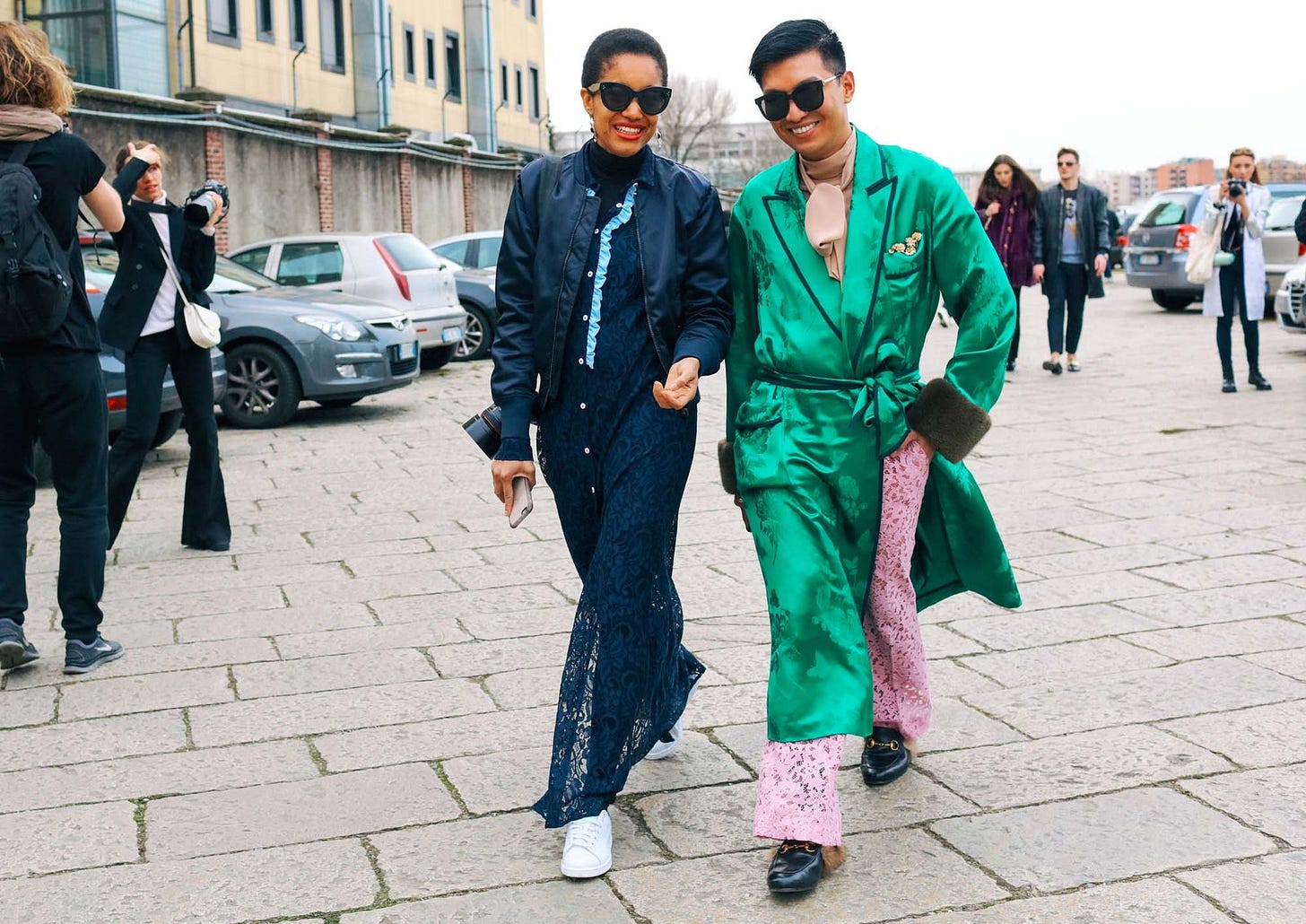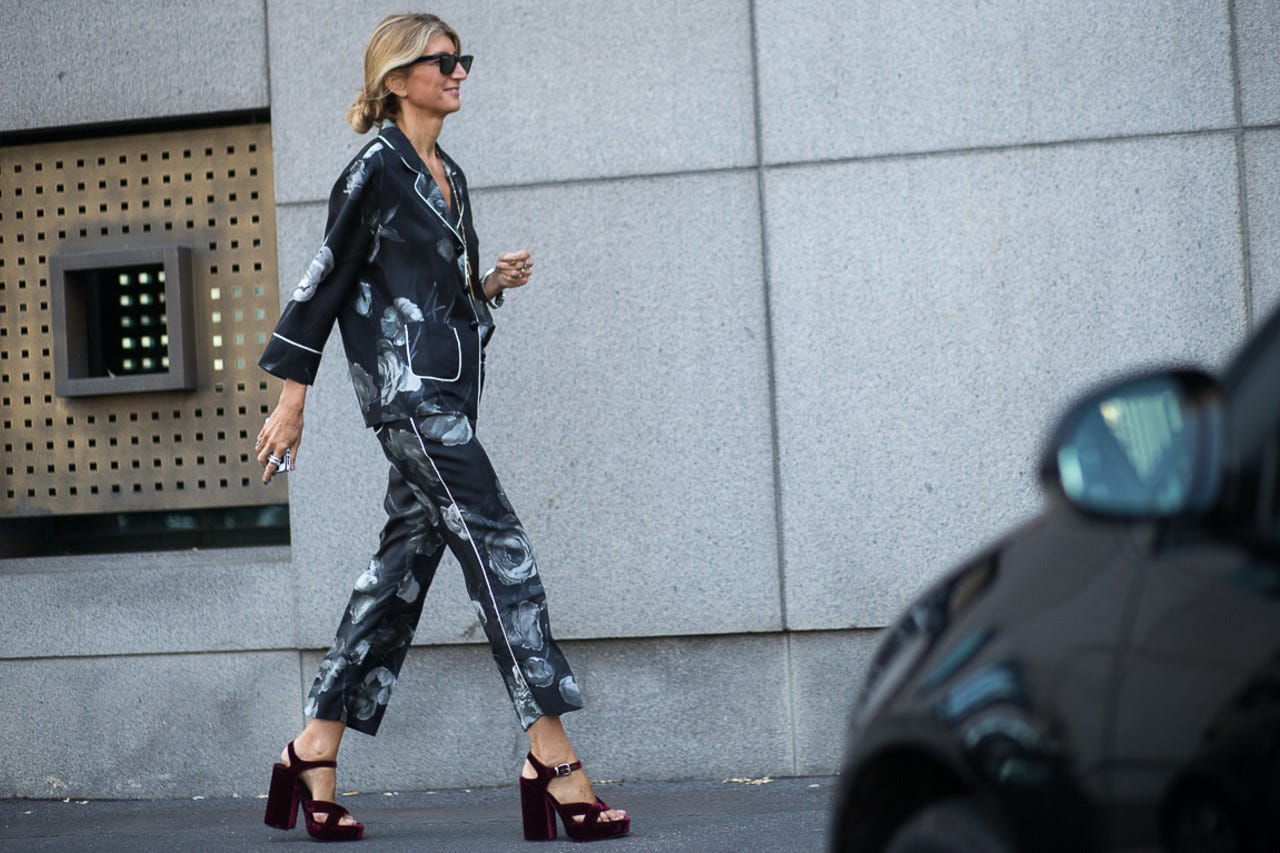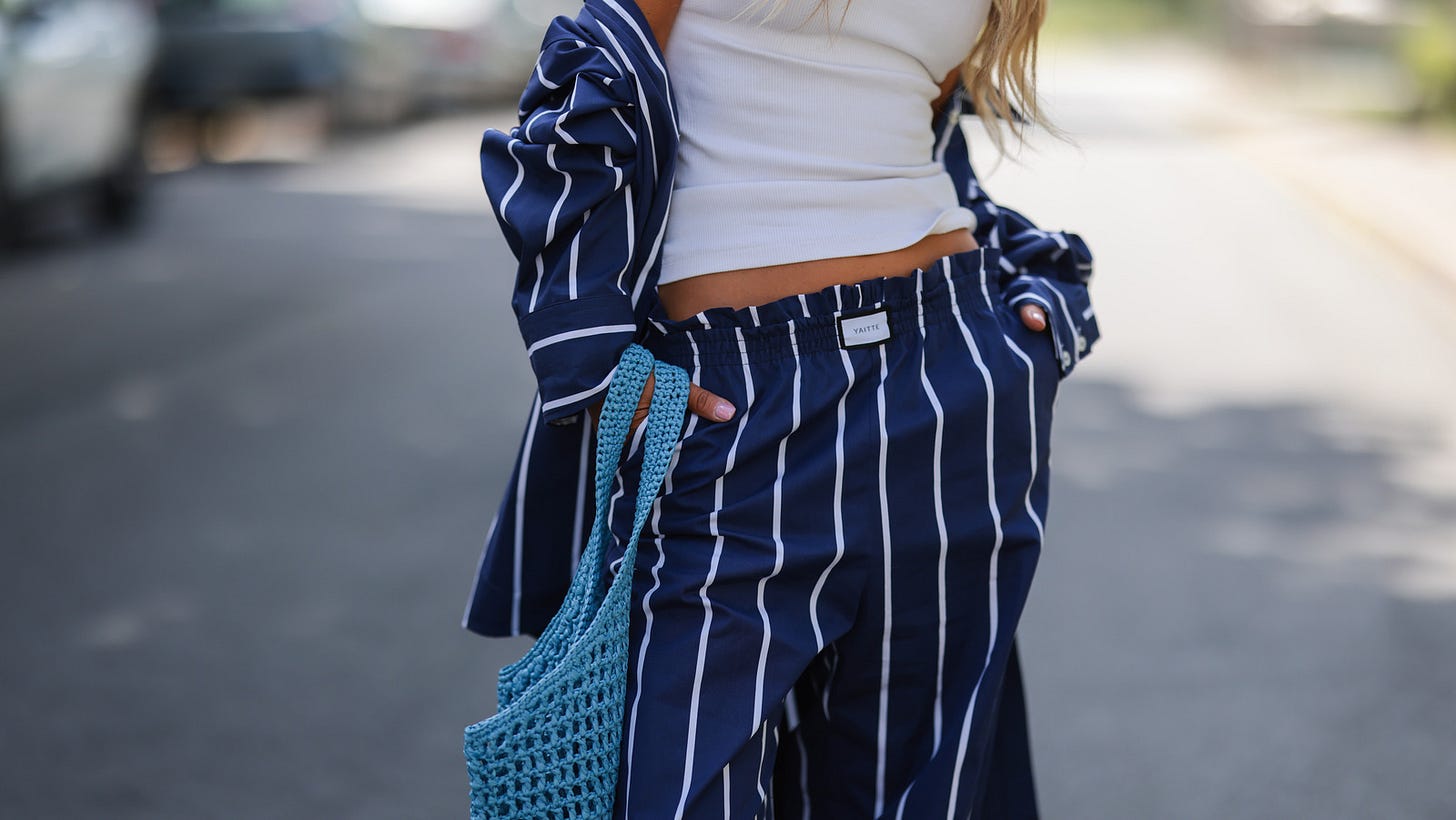I was originally going to include this in our weekly roundup, but with awards season already in full swing, there’s a lot of fashions to get through this week, so we’ll let this have its own moment. I thought we’d intellectualize the rise in pajamas as everydaywear a little bit, because fashion isn’t that serious (this is sarcasm), and I can’t help but feel like everything being marketed at us right now is trying to make us incredibly passive and detached.
Pajamas as ready-to-wear are obviously nothing new, but it’s the new ways in which they’re being marketed and “upgraded” that I think are important to pay attention to.
I was reading Amy Odell’s newsletter, Back Row, and she mentioned how WGSN’s consumer insights dubbed 2026 “The Great Exhaustion,” referring to the wide spread burnout everyone has been feeling amongst all the noise that has been exasperated by the “polycrisis.” They talk about “radical optimism” and how focusing on the little things that make us happy can help amongst all the chaos. So, essentially, we should all be a little more oblivious for best emotional results.
WGSN also reports that the top beauty trend of 2025 will be “therapeutic laziness” and how “day-jamas” (pajamas as ready-to-wear) will be pitched as sweatsuit alternatives— some of which will be infused with things like CBD and collagen. They write, “Our data shows sleepwear outperforming dresses and swimwear within the resortwear mix over the past two-year period”
As cultural apathy grows, extremes in fashion emerge. This shift reflects Georg Simmel’s theory of fashion as a dialectic between the “desire to be in and the fear of being out.” In this era of polycrisis, being “in” means engaging with clothing that speaks to mindfulness and comfort while simultaneously subverting those very ideals through extravagant details or unconventional presentations. These extremes in practicality and novelty become a way for consumers to externalize their internal contradictions—a longing for both simplicity and spectacle.
I feel that we’ve already started to see fashion slowly respond to this by putting more practical clothing on the runway. Prada has embraced comfortable footwear, Bottega offers a trompe l’oeil pajama, everyone is pairing functional jackets with their sequin dresses, etc. During times of recession, it is common for consumers to spend money on smaller luxuries, like trends that are more affordable. It becomes more about the symbolism of the items, instead of what they actually are. In The Fashion System, Roland Barthes writes, “Clothing is a system of signs, an array of symbols that communicate social status, identity, and cultural meaning,” and these smaller luxuries, like elevated pajamas, fulfill both symbolic and emotional needs. Novelty also becomes appealing, and pajamas are that sweet spot in the middle. They are very practical, but when placed into the everyday and marketed in a way that speaks to this era of apathy, they can be subverted. Pajamas become a uniform for disengagement and self-care by bringing rest and intimacy into the public sphere, and when made of the highest quality, they encourage you to intentionally decay. By embracing pajamas as daywear, consumers opt out of the fast-paced, high-stress demands of modern life. They want us to SLEEP— literally, but even more so metaphorically.
The more I thought of everyday pajamas as our answer to leisurely, domestic, ignorant bliss, the more I started to think about Walter Benjamin’s Arcades Project, where he discusses the commodification of everyday objects into “dream images” of modernity. Pajamas, in this sense, become dreamlike— ordinary yet ~elevated~. Benjamin identifies arcades as “dream worlds” of capitalism, where commodities take on a magical quality, luring consumers with their promise of fulfillment and status. When we look at a trend like “day-jamas.,” the "dream world" effect transforms a practical garment into a desirable luxury item. They become a promise of relaxation, luxury, and mindfulness in a chaotic world, convincing everyone that they too can live a life of leisure, although their tax bracket would argue otherwise.
In Arcades Project Benjamin also explored the idea of the flâneur— a detached observer of urban life, often wandering through the arcades. The flâneur embodies both the consumer and the critic, simultaneously enchanted by the goods on display and aware of their constructed allure. This duality mirrors how modern consumers engage with fashion. Consumers become flâneurs in a digital arcade, scrolling through Instagram or online stores, observing and participating in the commodification of rest and self-care. Pajamas then symbolize the contradictions of modern life—seeking comfort while performing identity through consumption. This highlights the commodification of experiences and how it reduces individuals to passive spectators.
Today, this passivity translates into political detachment, as citizens grow disillusioned with traditional systems of change, retreating instead into personal spheres of consumption and individualistic needs. This detachment can pave the way for authoritarian ideologies to gain traction, exploiting a public too tired and overwhelmed to resist. By focusing on self-preservation and mindfulness, individuals may inadvertently neglect collective action, leaving a vacuum for authoritarian movements to exploit. Fascism capitalizes on apathy by positioning itself as the antidote to chaos. When citizens feel overwhelmed and detached, authoritarian regimes offer the illusion of simplicity, control, and strength. By presenting themselves as saviors and convincing us that everyone except them is the enemy, they appeal to those seeking refuge from the noise and complexity of modern life. The flâneur’s ambivalence reflects this dynamic: while critical of the spectacle, the flâneur does little to disrupt it. They just wear their hyaluronic acid, marabou feather trimmed, silk pajamas, and think, “well, it’s not happening to me, so why should I care?” Modern fatigue fosters a culture of observation rather than participation, allowing fascist ideologies to spread unchecked.
Now please, I am not calling you a fascist because you want to wear your kitten heels with your favorite floral print pajamas to brunch. I have loved a pajamas since I was still young enough for my mother to hurt my feelings, and so did the silky textiles of the 1920s and 30s. As usual, I just ask you to be mindful of what it is that is being marketed at you, and why. Recognizing the constructed nature of these spectacles and trends opens the possibility for critique and action, reminding us that even in an era of exhaustion, engagement remains essential.








